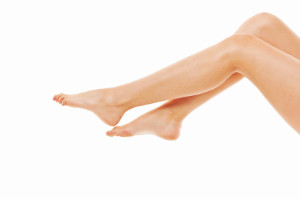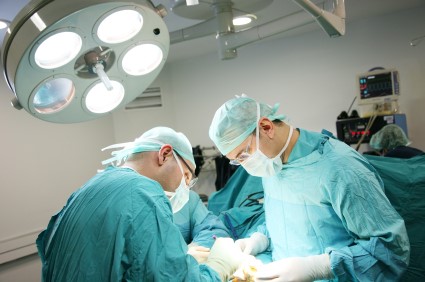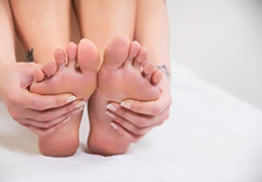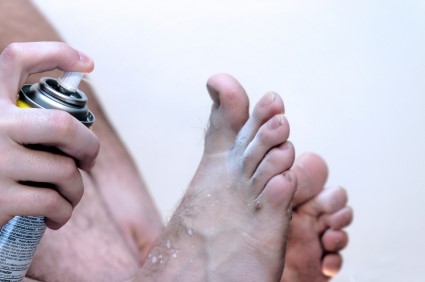Items filtered by date: January 2017
Finding the Right Shoes for Women
 It is recommended by the Centers for Disease Control and Prevention that “at least two and a half hours per week” of walking should be the minimum amount of aerobic activity to stay healthy. However, at least 57 percent of women fail to meet this standard. In order to get the right amount of exercise, women need the right shoes. When finding properly-fitting shoes, make sure that your shoes have a wide toe box, allowing your toes to move naturally. Look for shoes that have “seamless uppers,” or “little stitching and no rough edges to rub against your feet.” Overall, good shoes should offer protection and support.
It is recommended by the Centers for Disease Control and Prevention that “at least two and a half hours per week” of walking should be the minimum amount of aerobic activity to stay healthy. However, at least 57 percent of women fail to meet this standard. In order to get the right amount of exercise, women need the right shoes. When finding properly-fitting shoes, make sure that your shoes have a wide toe box, allowing your toes to move naturally. Look for shoes that have “seamless uppers,” or “little stitching and no rough edges to rub against your feet.” Overall, good shoes should offer protection and support.
Finding a properly-fitting shoe is important in reducing injuries and preventing foot problems. For more information about treatment, contact one of our podiatrists from Pennsylvania. Our doctors will treat your foot and ankle needs.
Proper Shoe Fitting
A common concern when it comes to foot health, having properly fitted shoes can help prevent injuries to the foot. Out feet affect our posture and gait, which in turn affects the biomechanics and overall bodily structure. With 33 joints, 26 bones, and over 100 ligaments, the potential for serious injury is much greater than one realizes. Although the feet cease growth in adulthood, they still change shape as they mature. Here are some factors to consider when it comes to investing in proper fitting shoes:
- Be sure the shoes fit correctly right away
- Ensure the ball of your foot fits comfortably in the widest portion of the shoes
- Even though they may look fashionable, improper fitting shoes can either create adverse conditions or exacerbate existing ones you may already have
- Walk along a carpeted surface to ensure the shoes comfortably fit during normal activity
Keeping in mind how shoes fit the biomechanics of your body, properly-fitting shoes are vitally important. Fortunately, it is not difficult to acquire footwear that fits correctly. Be sure to wear shoes that support the overall structure of your body. Do your feet a favor and invest in several pairs of well-fitted shoes today.
If you have any questions please feel free to contact one of our offices located in Plymouth Meeting and Ambler, PA . We offer the newest diagnostic and treatment technologies for all your foot and ankle needs.
Daily Foot Care During the Winter
 As the winter months are here, that means the weather is becoming colder, and as a result, your feet become susceptible to all sorts of maladies. Some tips for keeping your feet warm and avoiding any foot complications involve wearing properly-fitting, waterproof, snow-resistant shoes, breathable socks that prevent moisture from building up and practicing proper foot hygiene. Make sure to see your podiatrist if you notice any foot problems.
As the winter months are here, that means the weather is becoming colder, and as a result, your feet become susceptible to all sorts of maladies. Some tips for keeping your feet warm and avoiding any foot complications involve wearing properly-fitting, waterproof, snow-resistant shoes, breathable socks that prevent moisture from building up and practicing proper foot hygiene. Make sure to see your podiatrist if you notice any foot problems.
Everyday foot care is very important to prevent infection and other foot ailments. If you need your feet checked, contact one of our podiatrists from Pennsylvania. Our doctors can provide the care you need to keep you pain-free and on your feet.
Everyday Foot Care
Often, people take care of their bodies, face and hair more so than they do for their feet. But the feet are a very important aspect of our bodies, and one that we should pay more attention to. Without our feet, we would not be able to perform most daily tasks.
It is best to check your feet regularly to make sure there are no new bruises or cuts that you may not have noticed before. For dry feet, moisturizer can easily be a remedy and can be applied as often as necessary to the affected areas. Wearing shoes that fit well can also help you maintain good foot health, as well as making it easier to walk and do daily activities without the stress or pain of ill-fitting shoes, high heels, or even flip flops. Wearing clean socks with closed shoes is important to ensure that sweat and bacteria do not accumulate within the shoe. Clean socks help to prevent Athlete’s foot, fungi problems, bad odors, and can absorb sweat.
If you have any questions please feel free to contact one of our offices located in Plymouth Meeting and Ambler, PA . We offer the newest diagnostic and treatment technologies for all your foot and ankle needs.
The Effects of Wearing Shoes too Small
 In a recent study focusing on the effects of shoes on women’s feet, 88% of the women included were wearing shoes that were too small for their feet. 356 women were included in the study. Most of the women had not re-measured their feet in over ten years, and over 50% stated that they experienced daily foot pain from their shoes. Wearing shoes that are too tight can make way for the development of foot conditions such as bunions, hammertoes, corns, and calluses, and can even result in surgery for the treatment or removal of such conditions. Surgery is often seen as the final option for the treatment of many of these conditions; to lessen the possibility of surgery and the development of these conditions in general, always wear shoes of the proper size.
In a recent study focusing on the effects of shoes on women’s feet, 88% of the women included were wearing shoes that were too small for their feet. 356 women were included in the study. Most of the women had not re-measured their feet in over ten years, and over 50% stated that they experienced daily foot pain from their shoes. Wearing shoes that are too tight can make way for the development of foot conditions such as bunions, hammertoes, corns, and calluses, and can even result in surgery for the treatment or removal of such conditions. Surgery is often seen as the final option for the treatment of many of these conditions; to lessen the possibility of surgery and the development of these conditions in general, always wear shoes of the proper size.
Foot surgery is sometimes necessary to fix a foot ailment. To learn more, contact our podiatrists from Michigan Foot and Ankle. Our doctors will assist you with all of your foot and ankle needs.
When Is Surgery Necessary?
Foot and ankle surgery is generally reserved for cases in which less invasive, conservative procedures have failed to help with the problem. Some of the cases in which surgery may be necessary are:
- Removing foot deformities like bone spurs and bunions
- Severe arthritis that has caused bone issues
- Cosmetic reconstruction
What Types of Surgery Are There?
The type of surgery you receive will depend on the nature of the problem you have. Some of the possible surgeries include:
- Bunionectomy for painful bunions
- Surgical fusion for realignment of bones
- Neuropathy decompression surgery to treat nerve damage
Benefits of Surgery
Although surgery is usually a last resort, it can provide more complete pain relief compared to non-surgical methods and may allow you to finally resume full activity.
Surgical techniques have also become increasingly sophisticated. Techniques like endoscopic surgery allow for smaller incisions and faster recovery times.
If you have any questions, please feel free to contact our offices located in Michigan. We offer the newest diagnostic and treatment technologies for all your foot care needs.
Softening Corns and Calluses for Removal
 Among foot conditions, corns and calluses are often seen as some of the more harmless concerns. Regardless, if a corn or callus does become troublesome, there are methods available for removal. Because calluses are essentially small areas of thick, hardened skin, softening calluses can help aid in their removal. Soaking the feet in warm water and avoiding using harsh soaps while washing can help maintain softness of the skin. Hard areas can also be buffed away using a pumice stone. If you are suffering from corns and calluses and seek ways to remove them, consult with your podiatrist.
Among foot conditions, corns and calluses are often seen as some of the more harmless concerns. Regardless, if a corn or callus does become troublesome, there are methods available for removal. Because calluses are essentially small areas of thick, hardened skin, softening calluses can help aid in their removal. Soaking the feet in warm water and avoiding using harsh soaps while washing can help maintain softness of the skin. Hard areas can also be buffed away using a pumice stone. If you are suffering from corns and calluses and seek ways to remove them, consult with your podiatrist.
If you have any concerns regarding your feet and ankles, contact Dr. Michael E. Newman of Pennsylvania. Our doctors can provide the care you need to keep you pain-free and on your feet.
Corns: What are they? And how do you get rid of them?
Corns can be described as areas of the skin that have thickened to the point of becoming painful or irritating. They are often layers and layers of the skin that have become dry and rough, and are normally smaller than calluses.
Ways to Prevent Corns
There are many ways to get rid of painful corns such as wearing:
- Well-fitting socks
- Comfortable shoes that are not tight around your foot
- Shoes that offer support
Treating Corns
Treatment of corns involves removing the dead skin that has built up in the specific area of the foot. Salicylic acid can help in getting rid of these corns because it dissolves keratin, which is the protein that makes up a good majority of corns. Podiatrists recommend that people with diabetes not use salicylic acid but should consult with their podiatrist regarding the treatment of corns.
If you have any questions please feel free to contact our office located in Plymouth Meeting and Ambler, PA. We offer the newest diagnostic and treatment technologies for all your foot and ankle needs.
Understanding Athlete’s Foot
 It certainly is no misnomer that one of the most prominent fungal infections is called Athlete’s foot. Both professional and recreational athletes most likely have suffered this irritating condition. If your foot is red, itching, or burning, particularly between the toes, be advised that these are the chief symptoms of Athlete’s foot. Antifungal powders and sprays can be used to cure the condition in most cases. In order to avoid contracting Athlete’s foot, make sure to keep your feet dry, change your socks if they get wet or dirty, and wear sandals or flip-flops in any public wet area. Whether you play sports, exercise, or just walk around, make sure you take steps to keep your feet covered, healthy, clean, and thus fungus-free.
It certainly is no misnomer that one of the most prominent fungal infections is called Athlete’s foot. Both professional and recreational athletes most likely have suffered this irritating condition. If your foot is red, itching, or burning, particularly between the toes, be advised that these are the chief symptoms of Athlete’s foot. Antifungal powders and sprays can be used to cure the condition in most cases. In order to avoid contracting Athlete’s foot, make sure to keep your feet dry, change your socks if they get wet or dirty, and wear sandals or flip-flops in any public wet area. Whether you play sports, exercise, or just walk around, make sure you take steps to keep your feet covered, healthy, clean, and thus fungus-free.
Athlete’s foot is an inconvenient condition that can be easily reduced with the proper treatment. If you have any concerns about your feet and ankles, contact Dr. Michael E. Newman of Pennsylvania. Our doctors can provide the care you need to keep you pain-free and on your feet.
Athlete’s Foot: The Sole Story
Athlete's foot, also known as tinea pedis, can be an extremely contagious foot infection. It is commonly contracted in public changing areas and bathrooms, dormitory style living quarters, around locker rooms and public swimming pools, or anywhere your feet often come into contact with other people.
Solutions to Combat Athlete’s Foot
- Hydrate your feet by using lotion
- Exfoliate
- Buff off nails
- Use of anti-fungal products
- Examine your feet and visit your doctor if any suspicious blisters or cuts develop
Athlete’s foot can cause many irritating symptoms such as dry and flaking skin, itching, and redness. Some more severe symptoms can include bleeding and cracked skin, intense itching and burning and even pain when walking. In the worst cases, athlete’s foot can cause blistering as well. Speak to your podiatrist for a better understanding of the different causes of athlete’s foot, as well as helping you figure out which treatment options are best for you.
If you have any questions please feel free to contact one of our offices located in Plymouth Meeting and Ambler, PA. We offer the newest diagnostic and treatment technologies for all your foot and ankle needs.
